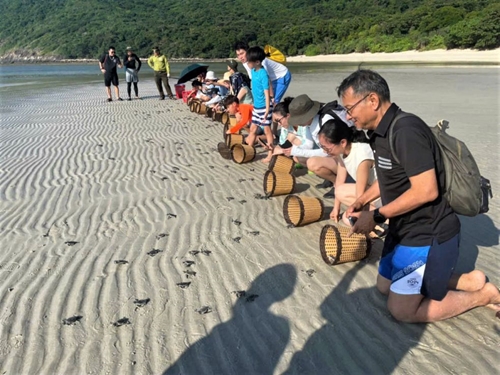Recognized as Vietnam’s most important sea turtle nesting site, the park located in Con Dao island in Ho Chi Minh City continues to lead marine conservation in the country.
    |
 |
|
Turtle releasing in Con Dao (Photo: laodong.vn) |
According to the park’s mid-year report, rangers relocated 553 nests, protecting over 54,000 eggs. So far, 166 nests have hatched, resulting in 4,464 hatchlings safely returned to the sea.
Additionally, rangers tagged 123 mother turtles and transferred nine nests, containing 757 eggs, to the Dat Doc beach near Six Senses Resort. Seven of those nests successfully hatched, releasing 388 more turtles.
Two turtles entangled in fishing nets were rescued and rehabilitated, while eight dead turtles were buried following environmental protocols.
The park also organized three volunteer programs in partnership with the International Union for Conservation of Nature (IUCN), drawing 58 participants focused on sea turtle protection.
Since 2019, Con Dao has run a dedicated rescue project to combat climate change impacts on turtle populations. In that time, over 13,600 nests have been protected, resulting in the release of nearly 949,000 baby turtles. More than 2,000 mother turtles were tagged, and nine stranded turtles were rescued. Rangers have also handled and preserved 65 dead endangered marine species, including dugongs and turtles, for education and research purposes.
In a landmark 2019 collaboration, 500 incubated turtle eggs were transferred to the Cu Lao Cham Marine Protected Area in the central province of Quang Nam for population recovery research. The hatch rate was a high 95.5%.
As part of habitat restoration efforts, Dat Doc Beach has been revived as a turtle nesting site. Since 2019, 13 turtles have laid over 1,400 eggs there, and 464 nests have been moved to the site for safe incubation. More than 29,000 hatchlings have been released from Dat Doc alone.
Nguyen Van Tra, deputy head of the park’s Conservation and International Cooperation Division, said the 2025 conservation plan is built on three pillars: in-site protection, scientific research and cooperation, and public awareness.
Volunteer teams and officers continue 24/7 patrols during peak nesting season from April to October across 18 beaches, he said.
“Our goal is to ensure every nest is found and safely relocated to avoid tides and predators.”
Tagging efforts will help track migration routes and feeding areas, contributing valuable data for national and global conservation strategies, he said.
In 2025, the park will expand collaboration with local and international organizations to share expertise and apply modern conservation technologies.
Eco-tourism centered on turtle nesting has become a popular and educational attraction in Con Dao, though it is tightly regulated.
Tour group sizes are limited, flash photography is banned, and visitors must keep a respectful distance from nesting turtles.
According to the park’s Eco-tourism and Environmental Protection Division, more than 22,000 visitors came to the park in the first half of 2025, with nearly 3,000 joining eco-tourism activities.
Nguyen Chu Hoi, a National Assembly deputy, said that the park was the first in the country to gain international recognition and remains a pioneer in marine conservation.
“Thanks to early conservation efforts, scientists’ hopes for Con Dao have become reality. It’s a model for other marine protected areas,” he said.
Hon Bay Canh, part of the park, is the only place in Vietnam where turtle conservation is consistently successful.
While similar models are being tested in other coastal areas, their results remain early-stage.
“Con Dao’s success is a source of national pride and a benchmark for sustainable development.”
Nguyen Van Nga, head of the park’s Eco-tourism and Environmental Protection Division, said turtle nesting tours are a unique product that must be carefully managed to avoid disrupting turtles.
Eco-tourism focused on turtle nesting is special and educational, but it requires strict regulation, he said.
“We’re developing more eco-tourism services that allow visitors to experience conservation first-hand.”
The park is also expanding environmental education in local schools across the Con Dao Special Zone, and its environmental education center is being upgraded into an interactive hub showcasing sea turtles and the island’s biodiversity.
The park’s volunteer program will continue to attract youth and nature lovers nationwide.
Sea turtle conservation is not just Con Dao’s responsibility. It’s a shared mission, he said.
“Protecting this endangered species also protects a precious part of our natural heritage and contributes to a greener, more sustainable future.”
With clear goals and actionable steps, the park’s 2025 Sea Turtle Conservation and Management Plan reflects a strong commitment to long-term marine protection.
Source: VNA